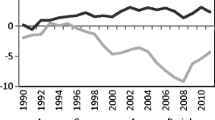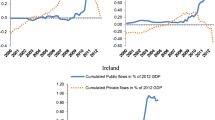Abstract
This paper analyses the adjustment mechanism in the euro area prior to the crisis. Results show that the real exchange rate adjusted to redress cyclical divergences and that after monetary unification, real exchange rate dynamics became less reactive to country-specific shocks but also less persistent. Regulations affecting price and wage nominal flexibility and employment protection play a role in the adjustment mechanism. Indicators of product and labour regulations appear to matter for both the reaction of price competitiveness to cyclical divergences and for the inertia of competitiveness indicators.
Similar content being viewed by others
Author information
Authors and Affiliations
Additional information
The views expressed in this paper are those of the authors only and do not necessarily represent those of the institutions with which the authors are affiliated. Eric Ruscher and Alfonso Arpaïa provided valuable comments on a previous version of the paper.
Rights and permissions
About this article
Cite this article
Biroli, P., Mourre, G. & Turrini, A. The adjustment mechanism in the Euro Area. Intereconomics 48, 159–166 (2013). https://doi.org/10.1007/s10272-013-0457-8
Published:
Issue Date:
DOI: https://doi.org/10.1007/s10272-013-0457-8




